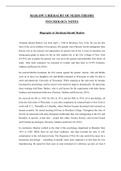MASLOW`S HIERACHY OF NEEDS THEORY
PSYCHOLOGY NOTES
Biography of Abraham Harold Maslow
Abraham Harold Maslow was born April 1, 1908 in Brooklyn, New York. He was the first
born of the seven children of his parents. His parents were illiterate Jewish immigrants from
Russia. Due to the pressure and expectations his parents had of him in terms of education and
having good grades to better his life, he first studied law at the City College of New York
(CCNY) just to please his parents, law was never his passion and preferably first choice of
study. After three semesters, he relocated to Cornell, and then back to CCNY (Einstein,
Addams and Roosevelt, 2016).
He married Bertha Goodman, his first cousin, against his parents’ desires. Abe and Bertha
went on to have two daughters. He and Bertha relocated to Wisconsin in order for him to
enrol and attend the University of Wisconsin. While studying at the university he became
fascinated by psychology, and his school work started to improve dramatically. He spent time
there working with Harry Harlow, who is well known for his experiments with baby rhesus
monkeys and attachment behaviour (Einstein, Addams and Roosevelt, 2016).
He received his BA in 1930, his MA in 1931, and his PhD in 1934, all in psychology, all
from the University of Wisconsin. A year after completion, he returned back to New York to
work with E. L. Thorndike at Columbia, where Maslow became fascinated with research on
human sexuality. He started teaching full time at Brooklyn College. Throughout this time of
his life, he interacted with many European intellectuals that were immigrating to the US, and
Brooklyn in specific, at that time – people like Adler, Fromm, Horney, and several Gestalt
and Freudian psychologists (Einstein, Addams and Roosevelt, 2016).
In conclusion, Maslow worked as the chair of the psychology department at Brandeis from
1951 to 1969. While there he met Kurt Goldstein, who had invented the idea of self-
actualization in his well-known book, The Organism (1934). He also started his cause for a
humanistic psychology – something eventually much more imperative to him than his own
hypothesizing. He spend his final years in semi-retirement in California, up until, on June 8
, 1970, he died of a heart attack after years battling with ill health (Einstein, Addams and
Roosevelt, 2016).
Introduction
Maslow’s hierarchy of needs is a theory of psychology explaining human motivation based
on the pursuit of different levels of needs. The theory states that humans are motivated to
fulfil their needs in a hierarchical order. This order begins with the most basic needs before
moving on to more advanced needs. The ultimate goal, according to this theory, is to reach
the fifth level of the hierarchy: self-actualization.
Maslow’s ideas have been applied successfully to mental health relating to several
populations such as people struggling with homelessness (Padgett, Smith, Derejko, Henwood,
& Tiderington, 2013) and children in crisis. Maslow’s hierarchy of needs is generally
understood as five layers organised in sequence in a pyramid diagram. But, in his later work,
Maslow (1969a as cited in Koltko-Rivera, 2006) incorporated a sixth level, self-
transcendence.
Human needs are insatiable, therefore, it is essentially part of human nature and
characteristics to constantly wish to attain more and more things in the human environment.
The hierarchy of needs address general needs that affect all individuals irrespective of
national origin (Tay & Diener, 2011). Human beings are hypothesized as inspired to grow
fulfilment of needs often shifts or is disrupted. Practitioners can use Maslow’s framework as
a practical guide while assessing clients and establishing client goals. While Maslow’s (1943)
hierarchy of needs was designed to be linear and hierarchical, a post-modern, humanistic
perspective allows for acknowledging a fluid human experience.
Maslow`s Hierarchy of needs Theory and practical Examples
There are five main levels to Maslow’s hierarchy of needs. These levels begin from the most
basic needs to the most advanced needs. Maslow originally believed that a person needed to
completely satisfy one level to begin pursuing further levels. A more modern perspective is
that these levels overlap. As a person reaches higher levels, their motivation is directed more
towards these levels. However, though their main focus is on higher levels, they will still
continue to pursue lower levels of the hierarchy but with less intensity. The needs are
explained as follows;




